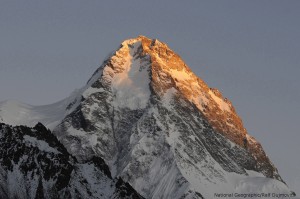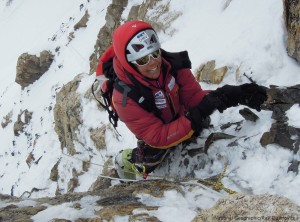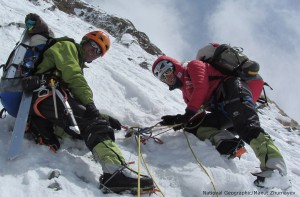Gerlinde Kaltenbrunner Sets Climbing Record

WASHINGTON —Reaching the top of K2 on her fourth attempt, Gerlinde Kaltenbrunner, a 40-year-old Austrian alpinist who resides in Germany, has become the first woman to summit all 14 of the world’s 8,000-meter peaks without using supplementary oxygen. Kaltenbrunner reached the top of K2, Earth’s second-tallest mountain, at 6:18 p.m. (local time) Tuesday, Aug. 23.
Kaltenbrunner, supported by grants from the National Geographic Society, was one of four climbers to reach the summit of K2. Other team members to summit were Maxut Zhumayev and Vassiliy Pivtsov of Kazakhstan and Darius Zaluski of Poland. Kaltenbrunner’s husband, Ralf Dujmovits of Germany, and photographer Tomas Heinrich of Argentina had turned back to base camp Aug. 19, judging the threat of an avalanche too great. Heinrich is documenting the expedition for an article for National Geographic magazine.
The K2 achievement also was a milestone for Zhumayev and Pivtsov; the ascent of K2 fulfilled their dream of climbing all 14 of the 8,000-meter peaks without using extra oxygen.
“I can't believe how lucky we were to reach the summit together in this fantastic weather, despite the difficult conditions during the ascent,” Kaltenbrunner said. “I would like to thank everyone for their ‘mental support,’ which I could clearly feel and which literally carried me to the summit.”

In the days approaching the summit, the team waded through waist-deep snow and battled high winds, with avalanche conditions that for several days made the attempt at the summit look implausible.
According to alpine record-keeper Eberhard Jurgalski, before the achievement of Kaltenbrunner, Zhumayev and Pivtsov, only 24 people in the world had made it to the top of all 14 tallest mountains. This includes Dujmovits, who ascended K2 in 1994 and completed scaling the entire set of peaks two years ago. Only 10 of the 24 made the ascents without supplementary oxygen.
Kaltenbrunner and her team began the march to the K2 northern base camp from Xinjiang, China, on June 17. A group of camels ferried the team, their equipment and supplies to the Chinese base camp, about 3,900 meters high, crossing the wild Shaksgam Valley in the process. The team then ascended the peak via the North Pillar, a direct line to the summit, first climbed in 1982 by a Japanese team.
K2, located on the Pakistan-China border, is 8,611 meters (28,251 feet) high and part of the Karakoram Range. It has a reputation of being the hardest of the 8,000-meter-high mountains to climb, due chiefly to its steepness and the resulting technical-climbing challenges as well as unpredictable weather conditions. Since K2 was first summited by an Italian team in 1954, about 300 climbers have stood on top of the mountain, but many have perished trying. Kaltenbrunner’s attempt to summit K2 last year ended with the death of team member Fredrick Ericsson.

Team member Dujmovits reported on returning to base camp on Aug. 19 that five huge boulders had crashed through the unoccupied camp, destroying most of the tents.
Kaltenbrunner, originally from Spital am Pyhrn in Upper Austria, began climbing the mountains surrounding her hometown as a child. While studying to be a nurse, she spent her free moments skiing and climbing. At age 23 Kaltenbrunner realized her greatest dream — climbing an 8,000-meter peak — making it to the secondary summit of Pakistan’s Broad Peak, a height of 8,027 meters. She saved money she earned as a nurse to fund expeditions in the Himalaya region and Karakoram, becoming a full-time alpinist in 2003.
Besides the National Geographic Society’s Expeditions Council, supporters of the expedition include OMV, VKB Bank, BANNER Batterien, Schöffel Sportbekleidung, GORE-TEX®products, LOWA, Deuter, Komperdell, Petzl, Valandré, adidas eyewear and Lorpen.
The expedition is chronicled at ngm.nationalgeographic.com/expedition-k2/dispatch-1.
